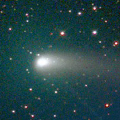
|
Now it is bright as 10.0 mag (Oct. 29, Osamu Miyazaki). It will brighten up to 9 mag, and will be observable in good condition in winter.
Date(TT) R.A. (2000) Decl. Delta r Elong. m1 Best Time(A, h)
Oct. 30 7 9.02 26 9.9 0.424 1.211 110 9.3 4:36 ( 0, 81)
Nov. 6 7 36.57 26 32.5 0.419 1.212 111 9.2 4:36 ( 0, 81)
|
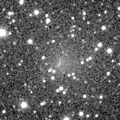
|
Now it is bright as 10.6 mag (Oct. 25, Chris Wyatt). It is observable at 10 mag in good condition from October to December. In the Northern Hemisphere, it locates somewhat low at the high light.
Date(TT) R.A. (2000) Decl. Delta r Elong. m1 Best Time(A, h)
Oct. 30 20 36.47 -31 47.3 1.095 1.439 86 9.9 18:33 ( 7, 23)
Nov. 6 21 3.30 -31 30.5 1.158 1.467 85 9.8 18:27 ( 6, 23)
|
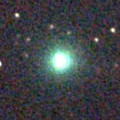
|
It brightened very rapidly. Now it is very bright as 9.5 mag (Oct. 13, Marco Goiato). The condition is bad in this apparition. In the Southern Hemisphere, it stays observable after this while the comet will be fading. But it stays locating low. It is not observable after this in the Northern Hemisphere.
Date(TT) R.A. (2000) Decl. Delta r Elong. m1 Best Time(A, h)
Oct. 30 12 21.86 -39 7.4 2.067 1.390 35 10.0 4:53 (311,-11)
Nov. 6 12 48.09 -42 6.5 2.134 1.456 36 10.5 4:59 (314,-11)
|
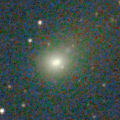
|
Now it is 10.5 mag (Oct. 29, Osamu Miyazaki). It stays bright as 10 mag until spring for a long time. In the Northern Hemisphere, it stays observable in good condition for a long time. In the Southern Hemisphere, it locates extremely low until November.
Date(TT) R.A. (2000) Decl. Delta r Elong. m1 Best Time(A, h)
Oct. 30 7 46.18 40 40.7 3.234 3.614 104 10.4 4:53 (214, 83)
Nov. 6 7 47.14 40 3.3 3.127 3.603 110 10.3 4:47 (180, 85)
|
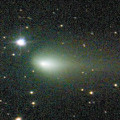
|
Now it is bright as 10.9 mag (Oct. 17, Osamu Miyazaki). It stays observable at 10-11 mag in excellent condition from summer to autumn.
Date(TT) R.A. (2000) Decl. Delta r Elong. m1 Best Time(A, h)
Oct. 30 6 46.73 11 53.3 1.031 1.701 114 10.4 4:14 ( 0, 67)
Nov. 6 6 52.58 10 49.1 1.003 1.724 119 10.5 3:52 ( 0, 66)
|
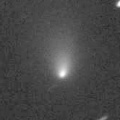
|
Now it is 11.0 mag (Oct. 29, Michael Jager). It will approach to Earth down to 0.2 a.u. in December, and it is expected to brighten up to 4 mag. In the Northern Hemisphere, it stays observable in good condition for a long time until December while the comet is brightening gradually. In the Southern Hemisphere, it is not observable until mid December.
Date(TT) R.A. (2000) Decl. Delta r Elong. m1 Best Time(A, h)
Oct. 30 11 48.59 35 2.3 1.628 1.422 60 11.1 4:53 (250, 37)
Nov. 6 11 58.24 34 29.3 1.401 1.314 63 10.4 4:59 (253, 42)
|
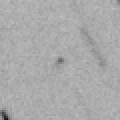
|
Now it is 12.9 mag (Oct. 25, Chris Wyatt). It will brighten rapidly up to 9 mag in winter. It will be observable in good condition. In the Southern Hemisphere, it is observable in excellent condition. It will be getting higher rapidly after this also in the Northren Hemisphere.
Date(TT) R.A. (2000) Decl. Delta r Elong. m1 Best Time(A, h)
Oct. 30 23 4.12 -52 43.0 1.195 1.703 101 11.7 20:29 ( 0, 3)
Nov. 6 23 4.98 -50 7.1 1.190 1.656 98 11.4 20:02 ( 0, 5)
|
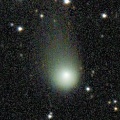
|
Now it is bright as 11.4 mag (Oct. 29, Osamu Miyazaki). It is expected to be observable at 5-6 mag for a long time from 2022 to 2023. In the Northern Hemisphere, it is not observable at the high light from 2022 autumn to 2023 summer. In the Southern Hemisphere, it is not observable until February. But it will be observable in good condition at the high light.
Date(TT) R.A. (2000) Decl. Delta r Elong. m1 Best Time(A, h)
Oct. 30 17 12.00 21 1.1 5.450 4.952 55 11.6 18:33 ( 91, 37)
Nov. 6 17 16.09 19 51.9 5.443 4.891 51 11.6 18:27 ( 92, 33)
|
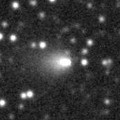
|
Major outburst occured on Oct. 17. Now it is very bright as 11.5 mag (Oct. 22, Marco Goiato). It stays observable in the evening sky for a while.
Date(TT) R.A. (2000) Decl. Delta r Elong. m1 Best Time(A, h)
Oct. 30 18 41.90 -20 55.0 1.924 1.724 63 11.9 18:33 ( 37, 24)
Nov. 6 19 1.69 -20 38.7 1.978 1.730 60 12.0 18:27 ( 38, 24)
|
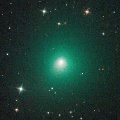
|
It brightened up to 9.5 mag in early summer (June 27, Marco Goiato). Now it is fading. It has already faded down to 13.4 mag (Oct. 25, Chris Wyatt). It will be unobservable soon in the Northern Hemisphere, or in November in the Southern Hemisphere.
Date(TT) R.A. (2000) Decl. Delta r Elong. m1 Best Time(A, h)
Oct. 30 17 20.15 -29 25.9 3.031 2.434 45 12.0 18:33 ( 47, 6)
Nov. 6 17 35.85 -30 21.4 3.128 2.478 41 12.3 18:27 ( 47, 5)
|
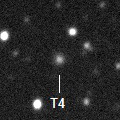
|
Now it is 13.8 mag (Oct. 9, Chris Wyatt). It is expected to brighten up to 11.5 mag in 2022. In the Southern Hemisphere, it stas observable in good condition for a long time, although it became extremely low temporarily from August to September. It is getting observable also in the Northern Hemisphere.
Date(TT) R.A. (2000) Decl. Delta r Elong. m1 Best Time(A, h)
Oct. 30 11 12.87 -25 54.3 5.276 4.623 44 13.1 4:53 (311, 9)
Nov. 6 11 19.69 -26 22.8 5.197 4.601 48 13.0 4:59 (315, 12)
|
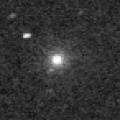
|
It was observed at 9-10 mag from late July to early August. Now it is not observable. It will appear in the morning sky in December, but it will be fainter than 15 mag at that time.
Date(TT) R.A. (2000) Decl. Delta r Elong. m1 Best Time(A, h)
Oct. 30 14 2.60 -7 52.0 2.563 1.581 6 13.0 4:53 (271,-12)
Nov. 6 14 17.91 -10 5.1 2.651 1.677 8 13.4 4:59 (276, -9)
|
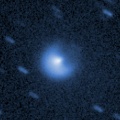
|
Major outburst occured on Sept. 25, and it brightened up to 10.0 mag (Oct. 1, Toshihiko Ikemura, Hirohisa Sato). Now it is fading. But it is bright as 11.5 mag still now (Oct. 28, Osamu Miyazaki).
Date(TT) R.A. (2000) Decl. Delta r Elong. m1 Best Time(A, h)
Oct. 30 4 52.71 32 15.6 5.132 5.926 139 13.3 2:21 ( 0, 87)
Nov. 6 4 49.99 32 16.3 5.071 5.928 147 13.3 1:50 ( 0, 87)
|

|
It brightened up to 12.3 mag from spring to summer (June 15, Marco Goiato). Now it is fading. It has already faded down to 13.8 mag (Sept. 8, Chris Wyatt). Now it is not observable. It will be observable again at 14 mag in November in the Northern Hemisphere, or in January in the Southern Hemisphere.
Date(TT) R.A. (2000) Decl. Delta r Elong. m1 Best Time(A, h)
Oct. 30 14 7.80 -1 38.3 4.775 3.810 12 13.9 4:53 (265,-10)
Nov. 6 14 11.04 -1 15.1 4.779 3.840 16 13.9 4:59 (269, -3)
|
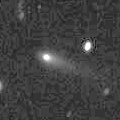
|
Now it is 13.7 mag (Oct. 25, Chris Wyatt). It is observable at 14 mag in excellent condition in autumn.
Date(TT) R.A. (2000) Decl. Delta r Elong. m1 Best Time(A, h)
Oct. 30 0 23.71 -3 32.9 0.776 1.698 147 14.0 21:48 ( 0, 52)
Nov. 6 0 26.85 -3 42.0 0.805 1.693 140 14.0 21:24 ( 0, 51)
|
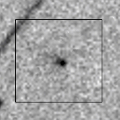
|
Now it is not observable. In the Southern Hemisphere, it will appear in the morning sky at 11 mag in late January, then it stays observable at 11 mag until June. In the Northern Hemisphere, it will appear in the morning sky in December, but it stays locating extremely low for a long time.
Date(TT) R.A. (2000) Decl. Delta r Elong. m1 Best Time(A, h)
Oct. 30 14 8.80 -9 36.6 3.046 2.057 4 14.3 4:53 (272,-14)
Nov. 6 14 24.36 -10 57.9 2.997 2.017 6 14.1 4:59 (276,-11)
|
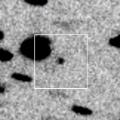
|
It will brighten up to 12 mag from winter to spring. In the Northern Hemisphere, it is appearing in the morning sky. In the Southern Hemisphere, it is not observable until January.
Date(TT) R.A. (2000) Decl. Delta r Elong. m1 Best Time(A, h)
Oct. 30 12 58.10 1 4.4 2.809 1.948 24 14.6 4:53 (273, 6)
Nov. 6 13 13.92 -0 41.4 2.742 1.912 26 14.4 4:59 (277, 9)
|
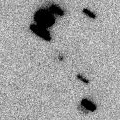
|
Now it is 17.3 mag (Oct. 24, E. Bryssinck). It will brightens rapidly. And it is expected to be observable at 12-13 mag in good condition from December to February. However, it is much fainter than this ephemeris recently.
Date(TT) R.A. (2000) Decl. Delta r Elong. m1 Best Time(A, h)
Oct. 30 21 44.53 -9 29.7 0.767 1.436 108 15.1 19:10 ( 0, 46)
Nov. 6 21 50.23 -9 59.2 0.767 1.381 102 14.7 18:48 ( 0, 45)
|
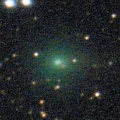
|
It brightened very rapidly up to 10.7 mag in July (July 20, Osamu Miyazaki). Now it is fading. It has already faded down to 15.9 mag (Oct. 8, Toshihiko Ikemura, Hirohisa Sato). It stays observable in the morning sky for a long time.
Date(TT) R.A. (2000) Decl. Delta r Elong. m1 Best Time(A, h)
Oct. 30 8 52.56 25 49.3 1.474 1.750 88 15.1 4:53 (291, 69)
Nov. 6 8 58.58 25 54.3 1.458 1.816 93 15.5 4:59 (302, 74)
|

|
Now it is 16.0 mag (Aug. 16, iTelescope Observatory, Siding Spring). It is expected to brighten up to 13 mag in 2022. In the Southern Hemisphere, it stays observable in good condition for a long time, although it became extremely low temporarily from September to October. In the Northern Hemisphere, it becomes observable temporarily in the extremely low sky in December. But it becomes unobservable again soon.
Date(TT) R.A. (2000) Decl. Delta r Elong. m1 Best Time(A, h)
Oct. 30 12 35.34 -34 37.4 4.643 3.826 31 15.2 4:53 (305,-10)
Nov. 6 12 38.55 -36 12.1 4.565 3.790 34 15.1 4:59 (310, -6)
|

|
Now it is 14.9 mag (Oct. 25, Chris Wyatt). It will be fading after this. In the Southern Hemisphere, it stays observable in good condition for a long time. It locates low in the Northern Hemisphere.
Date(TT) R.A. (2000) Decl. Delta r Elong. m1 Best Time(A, h)
Oct. 30 22 24.53 -25 28.1 4.236 4.688 111 15.1 19:49 ( 0, 30)
Nov. 6 22 23.60 -24 20.8 4.359 4.711 104 15.2 19:21 ( 0, 31)
|
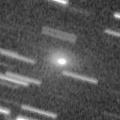
|
Now it is 14.3 mag (Oct. 4, Michael Jager). It stays 15 mag until November. It will be observable in excellent condition in the Northern Hemisphere. It locates somewhat low in the Southern Hemisphere.
Date(TT) R.A. (2000) Decl. Delta r Elong. m1 Best Time(A, h)
Oct. 30 7 5.73 29 27.3 1.096 1.732 111 15.2 4:33 ( 0, 84)
Nov. 6 7 14.09 30 38.8 1.062 1.753 117 15.2 4:14 ( 0, 86)
|
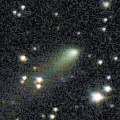
|
Now it is 14.2 mag (Oct. 21, Giuseppe Pappa). It will be fading after this. In the Northern Hemisphere, it stays observable in good condition for a long time, although it becomes extremely low temporarily in November. In the Southern Hemisphere, it is not observable until late January.
Date(TT) R.A. (2000) Decl. Delta r Elong. m1 Best Time(A, h)
Oct. 30 16 6.43 17 36.8 2.977 2.326 41 15.2 18:33 ( 97, 22)
Nov. 6 16 6.94 17 14.3 3.027 2.340 38 15.3 18:27 ( 99, 17)
|

|
Now it is 15.3 mag (Oct. 25, Chris Wyatt). It will be fading slowly after this. It will be unobservable in December.
Date(TT) R.A. (2000) Decl. Delta r Elong. m1 Best Time(A, h)
Oct. 30 19 33.58 -33 32.8 3.284 3.152 73 15.3 18:33 ( 20, 18)
Nov. 6 19 42.73 -33 7.6 3.388 3.166 68 15.4 18:27 ( 23, 18)
|

|
Now it is 15.9 mag (Oct. 8, Thomas Lehmann). It stays at 14-15 mag for a long time from 2021 to 2022. It is not observable from November to January.
Date(TT) R.A. (2000) Decl. Delta r Elong. m1 Best Time(A, h)
Oct. 30 16 30.52 -21 48.3 5.799 4.993 32 15.3 18:33 ( 60, 3)
Nov. 6 16 33.52 -22 37.6 5.859 4.993 26 15.3 18:27 ( 62, -1)
|
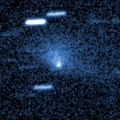
|
It brightened up to 10.1 mag in spring (Apr. 10, Marco Goiato). Now it is fading. It has already faded down to 15.3 mag (Oct. 14, Sandor Szabo). It stays observable in good condition for a long time after this while the comet will fading.
Date(TT) R.A. (2000) Decl. Delta r Elong. m1 Best Time(A, h)
Oct. 30 4 43.37 5 47.4 1.612 2.478 143 15.3 2:11 ( 0, 61)
Nov. 6 4 36.87 5 31.8 1.611 2.521 150 15.5 1:37 ( 0, 61)
|

|
Now it is 14.9 mag (Oct. 9, Chris Wyatt). It was expected to brighten up to 13 mag from spring to summer. But actually, it is fainter than originally expected. It will be fading slowly after this. In the Southern Hemisphere, it stays observable in good condition for a long time. In the Northern Hemisphere, it is not observable until July in 2022.
Date(TT) R.A. (2000) Decl. Delta r Elong. m1 Best Time(A, h)
Oct. 30 21 38.64 -72 37.4 3.773 3.781 82 15.4 19:05 ( 0,-17)
Nov. 6 21 49.18 -70 40.1 3.841 3.801 80 15.4 18:48 ( 0,-15)
|
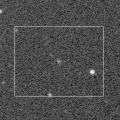
|
Now it is 16.1 mag (Oct. 11, Thomas Lehmann). It will brighten up to 12.5 mag in 2022 summer. In the Southern Hemisphere, it stays observable in excellent condition for a long time. In the Northern Hemisphere, it is not observable until August in 2022.
Date(TT) R.A. (2000) Decl. Delta r Elong. m1 Best Time(A, h)
Oct. 30 0 54.32 -76 28.4 4.179 4.279 89 15.4 22:15 ( 0,-21)
Nov. 6 0 16.18 -76 8.0 4.198 4.233 85 15.4 21:10 ( 0,-21)
|

|
Now it is 15.8 mag (Oct. 4, Thomas Lehmann). Now it is not observable. It will appear in the morning sky at 15 mag in January. Then it will brighten up to 13 mag in 2022 summer.
Date(TT) R.A. (2000) Decl. Delta r Elong. m1 Best Time(A, h)
Oct. 30 15 5.33 -16 35.8 4.239 3.275 12 15.4 18:33 ( 76,-10)
Nov. 6 15 15.53 -17 25.8 4.243 3.263 7 15.4 18:27 ( 77,-13)
|
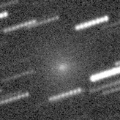
|
Bright new periodic comet. Now it is 14.5 mag (Oct. 8, Toshihiko Ikemura, Hirohisa Sato). It stays observable in good condition for a long time. It stays 14-15 mag until November. Juan Jose Gonzalez reported it is very bright as 11.8 mag on Oct. 7.
Date(TT) R.A. (2000) Decl. Delta r Elong. m1 Best Time(A, h)
Oct. 30 9 57.96 3 57.7 1.497 1.429 66 15.4 4:53 (303, 43)
Nov. 6 10 12.51 1 45.7 1.491 1.471 69 15.5 4:59 (310, 45)
|
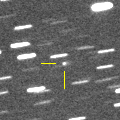
|
It brightened rapidly. Now it is 15.5 mag (Oct. 14, Sandor Szabo). It will be observable at 15 mag in excellent condition in winter.
Date(TT) R.A. (2000) Decl. Delta r Elong. m1 Best Time(A, h)
Oct. 30 8 20.68 21 39.1 2.177 2.457 94 15.6 4:53 (315, 72)
Nov. 6 8 27.25 20 52.4 2.093 2.458 99 15.5 4:59 (335, 75)
|
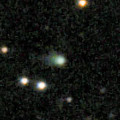
|
Now it is 15.5 mag (Oct. 14, Ken-ichi Kadota). It is expected to brighten up to 11 mag in 2023. In the Northern Hemisphere, it stays observable in good condition for a long time, although it becomes low temporarily in November. It is not observable in the Southern Hemisphere.
Date(TT) R.A. (2000) Decl. Delta r Elong. m1 Best Time(A, h)
Oct. 30 16 11.71 33 50.8 6.246 5.732 54 15.7 18:33 (112, 30)
Nov. 6 16 14.02 33 8.7 6.222 5.689 53 15.6 18:27 (113, 26)
|
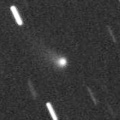
|
Now it is 15.9 mag (Sept. 24, D. Buczynski). In the Northern Hemisphere, it stays observable at 15-16 mag for a long time until early 2022, although it became extremely low temporarily from September to October. In the Southern Hemisphere, it is not observable until the end of 2021.
Date(TT) R.A. (2000) Decl. Delta r Elong. m1 Best Time(A, h)
Oct. 30 13 8.09 23 10.0 3.773 3.086 40 15.7 4:53 (253, 17)
Nov. 6 13 11.16 21 49.3 3.737 3.102 44 15.7 4:59 (258, 22)
|
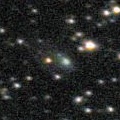
|
Now it is 15.4 mag (Oct. 26, R. Farfan). It is expected to brighten up to 11 mag from spring to summer in 2022. In the Southen Hemisphere, it locates somewhat low in 2021, but it will be observable in good condition at the high light for a long time. In the Northern Hemisphere, it is observable in good condition in 2021, but it will not be observable at the high light.
Date(TT) R.A. (2000) Decl. Delta r Elong. m1 Best Time(A, h)
Oct. 30 18 37.25 6 52.2 3.480 3.239 67 15.8 18:33 ( 60, 45)
Nov. 6 18 39.41 4 53.8 3.521 3.175 61 15.8 18:27 ( 62, 40)
|
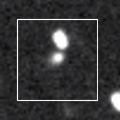
|
Now it is 15.7 mag (Oct. 25, D. Buczynski). It is expected to brighten up to 10 mag in 2023. In the Northern Hemisphere, it stays observable in good condition until 2023 autumn, although it became extremely low temporarily in September. In the Southern Hemipshere, it stays unobservable until 2023 summer.
Date(TT) R.A. (2000) Decl. Delta r Elong. m1 Best Time(A, h)
Oct. 30 12 43.56 34 13.8 6.544 5.996 52 15.9 4:53 (245, 27)
Nov. 6 12 47.17 34 33.1 6.412 5.940 57 15.8 4:59 (248, 32)
|
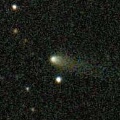
|
Now it is 14.8 mag (Oct. 3, Michael Jager). It will be fading rapidly after this. It will be fainter than 18 mag in February.
Date(TT) R.A. (2000) Decl. Delta r Elong. m1 Best Time(A, h)
Oct. 30 23 5.83 -17 10.1 1.616 2.319 123 15.8 20:31 ( 0, 38)
Nov. 6 23 9.25 -16 52.5 1.693 2.326 117 16.0 20:07 ( 0, 38)
|
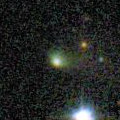
|
Now it is 15.5 mag (Oct. 14, Sandor Szabo). It continues brightening even after the perihelion passage. It may stay 15-16 mag for a while.
Date(TT) R.A. (2000) Decl. Delta r Elong. m1 Best Time(A, h)
Oct. 30 0 56.36 -14 51.2 2.154 3.023 145 15.9 22:20 ( 0, 40)
Nov. 6 0 54.75 -14 48.7 2.241 3.059 139 16.1 21:51 ( 0, 40)
|
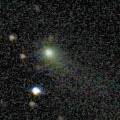
|
Now it is 16.0 mag (Oct. 8, Toshihiko Ikemura, Hirohisa Sato). It stays observable in good condition for a long time. But it will be fading after this.
Date(TT) R.A. (2000) Decl. Delta r Elong. m1 Best Time(A, h)
Oct. 30 22 55.88 2 25.8 1.455 2.220 129 16.0 20:21 ( 0, 58)
Nov. 6 22 58.37 2 52.5 1.531 2.232 122 16.1 19:56 ( 0, 58)
|
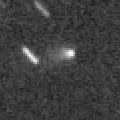
|
Now it is 17.5 mag (Oct. 10, Toshihiko Ikemura, Hirohisa Sato). It will brighten up to 15.5 mag in winter. In the Northern Hemisphere, it stays observable in good condition for a long time. It is not observable at all in the Southern Hemisphere. It is fainter than this ephemeris recently.
Date(TT) R.A. (2000) Decl. Delta r Elong. m1 Best Time(A, h)
Oct. 30 15 43.23 62 25.2 3.152 3.101 77 16.1 18:33 (146, 34)
Nov. 6 15 46.79 62 12.5 3.111 3.080 79 16.1 18:27 (147, 32)
|
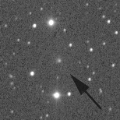
|
It brightened up to 14.2 mag in early summer (June 10, Thomas Lehmann). Now it is fading. In the Northern Hemisphere, it is appearing in the morning sky. In the Southern Hemisphere, it will never be observable again.
Date(TT) R.A. (2000) Decl. Delta r Elong. m1 Best Time(A, h)
Oct. 30 13 9.87 28 14.4 2.947 2.351 44 16.1 4:53 (248, 19)
Nov. 6 13 26.22 29 24.0 2.927 2.397 49 16.1 4:59 (249, 23)
|
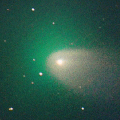
|
It brightened up to 9.7 mag in June (June 4, Michael Jager). Now it is fading. It has already faded down to 16.3 mag (Oct. 12, ATLAS-MLO, Mauna Loa). In the Southern Hemisphere, it stays observable in excellent condition for a long time. In the Northern Hemisphere, it becomes extremely low after this.
Date(TT) R.A. (2000) Decl. Delta r Elong. m1 Best Time(A, h)
Oct. 30 23 19.29 -39 16.1 1.538 2.130 112 16.1 20:44 ( 0, 16)
Nov. 6 23 22.88 -37 10.0 1.651 2.184 108 16.4 20:20 ( 0, 18)
|
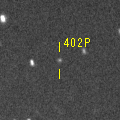
|
First return of a new periodic comet observed at 16 mag from 2003 to 2004. Now it is 16.7 mag (Oct. 25, ATLAS-MLO, Mauna Loa). It will brighten up to 16 mag in winter, and it will be observable in excellent condition.
Date(TT) R.A. (2000) Decl. Delta r Elong. m1 Best Time(A, h)
Oct. 30 6 41.13 0 47.4 3.446 3.947 113 16.1 4:08 ( 0, 56)
Nov. 6 6 41.26 0 43.2 3.358 3.944 119 16.1 3:41 ( 0, 56)
|
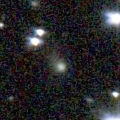
|
Now it is 16.1 mag (Oct. 14, ATLAS-MLO, Mauna Loa). It is expected to brighten up to 11 mag in 2023. In the Northern Hemisphere, it is observable in good condition in 2021. But it is observable only until November in 2022. In the Southern Hemisphere, it is not observable until February. But it will be observable in good condition at the high light.
Date(TT) R.A. (2000) Decl. Delta r Elong. m1 Best Time(A, h)
Oct. 30 17 37.27 25 51.3 6.295 5.907 62 16.3 18:33 ( 93, 44)
Nov. 6 17 40.75 24 45.6 6.304 5.859 59 16.2 18:27 ( 95, 40)
|
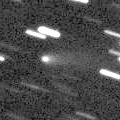
|
Now it is 16.0 mag (Oct. 16, Thomas Lehmann). It will be fading after this, and it will be fainter than 18 mag in December. In the Northern Hemisphere, it stays observable in good condition for a long time. It locates extremely low in the Southern Hemisphere.
Date(TT) R.A. (2000) Decl. Delta r Elong. m1 Best Time(A, h)
Oct. 30 8 30.45 34 59.1 1.305 1.708 95 16.3 4:53 (266, 77)
Nov. 6 8 44.08 36 16.1 1.279 1.741 99 16.5 4:59 (259, 81)
|
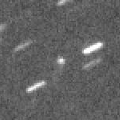
|
Now it is 17.0 mag (Oct. 2, Toshihiko Ikemura, Hirohisa Sato). It will brighten up to 16 mag in 2022. In the Northern Hemisphere, it stays observable in good condition for a long time. In the Southern Hemisphere, it is not observable until 2023.
Date(TT) R.A. (2000) Decl. Delta r Elong. m1 Best Time(A, h)
Oct. 30 9 25.86 63 26.6 3.873 4.077 94 16.5 4:53 (204, 56)
Nov. 6 9 34.99 65 46.4 3.772 4.053 99 16.5 4:59 (198, 56)
|
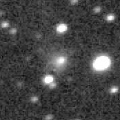
|
Now it is 16.2 mag (Oct. 7, Thomas Lehmann). It is observable at 16 mag from 2020 to 2021. It locates low in the Southern Hemisphere.
Date(TT) R.A. (2000) Decl. Delta r Elong. m1 Best Time(A, h)
Oct. 30 21 32.89 28 45.2 5.726 6.183 113 16.6 18:57 ( 0, 84)
Nov. 6 21 31.57 27 15.0 5.826 6.197 107 16.6 18:29 ( 0, 82)
|
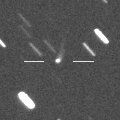
|
It was expected to brighten up to 14.5 mag from spring to summer. But actually, it is fainter than expected. Now it is 16.4 mag (Oct. 4, ATLAS-MLO, Mauna Loa). In the Southern Hemisphere, it stays observable for a long time. In the Northern Hemisphere, it is not observable after this.
Date(TT) R.A. (2000) Decl. Delta r Elong. m1 Best Time(A, h)
Oct. 30 11 47.83 -51 40.3 3.878 3.301 48 16.6 4:53 (325,-14)
Nov. 6 11 52.48 -51 52.2 3.902 3.343 49 16.7 4:59 (328,-11)
|
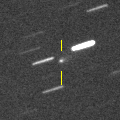
|
Now it is 16.6 mag (Oct. 8, Toshihiko Ikemura, Hirohisa Sato). It stays observable at 17 mag from autumn to winter. In the Northern Hemisphere, it stays observable in good condition. In the Southern Hemisphere, it stays extremely low until November.
Date(TT) R.A. (2000) Decl. Delta r Elong. m1 Best Time(A, h)
Oct. 30 10 44.32 12 22.4 2.095 1.793 58 16.7 4:53 (284, 40)
Nov. 6 10 59.34 10 26.4 2.050 1.802 61 16.7 4:59 (290, 42)
|

|
Now it is 17.0 mag (Oct. 17, Ken-ichi Kadota). It will brighten rapidly, and it will be observable at 13.5 mag in good condition from winter to spring.
Date(TT) R.A. (2000) Decl. Delta r Elong. m1 Best Time(A, h)
Oct. 30 9 23.46 19 3.7 2.797 2.788 79 16.9 4:53 (294, 60)
Nov. 6 9 31.58 18 32.7 2.680 2.763 84 16.7 4:59 (303, 64)
|
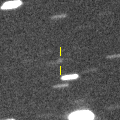
|
Now it is 17.3 mag (Oct. 2, Toshihiko Ikemura, Hirohisa Sato). It will brighten up to 15.5 mag, and will be observable in excellent condition in winter.
Date(TT) R.A. (2000) Decl. Delta r Elong. m1 Best Time(A, h)
Oct. 30 9 56.71 12 32.3 2.128 2.009 69 16.8 4:53 (294, 49)
Nov. 6 10 10.53 11 38.1 2.060 2.009 73 16.7 4:59 (300, 52)
|

|
It brightened up to 11.6 mag in winter (Feb. 18, Thomas Lehmann). Now it is fading. It has already faded down to 17.6 mag (Oct. 18, J. Drummond). In the Southern Hemisphere, it stays observable in good condition after this. In the Northern Hemisphere, it will never be observable after this.
Date(TT) R.A. (2000) Decl. Delta r Elong. m1 Best Time(A, h)
Oct. 30 2 44.72 -70 1.5 4.002 4.225 96 16.7 0:13 ( 0,-15)
Nov. 6 2 21.87 -69 13.8 4.091 4.289 94 16.8 23:16 ( 0,-14)
|
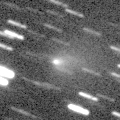
|
Outburst occured in early August, and it brightened up to 14.1 mag (Aug. 7, Michael Jager). Now it is fading. It has already faded down to 17.5 mag (Oct. 8, Toshihiko Ikemura, Hirohisa Sato). In the Northern Hemisphere, it stays observable in good condition. In the Southern Hemipsphere, it stays locating extremely low after this.
Date(TT) R.A. (2000) Decl. Delta r Elong. m1 Best Time(A, h)
Oct. 30 5 59.20 47 59.0 2.103 2.771 122 16.7 3:27 (180, 77)
Nov. 6 5 56.30 48 31.5 2.067 2.801 129 16.9 2:57 (180, 76)
|

|
Now it is 16.3 mag (Oct. 21, ATLAS-HKO, Haleakala). It stays at 16-17 mag from 2020 to 2021. In the Northern Hemisphere, it stays observable in good condition for a long time. In the Southern Hemisphere, it is not observable after this.
Date(TT) R.A. (2000) Decl. Delta r Elong. m1 Best Time(A, h)
Oct. 30 18 22.00 47 40.6 9.008 8.925 82 16.8 18:33 (125, 57)
Nov. 6 18 23.79 47 25.2 9.049 8.931 80 16.9 18:27 (124, 53)
|
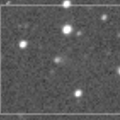
|
First return of a new periodic comet which brightened up to 17 mag in 2006. Now it is 17.4 mag (Sept. 27, N. Paul, E. Cortes). It stays 17 mag from 2021 to 2022. In the Southern Hemisphere, it stays observable in good condition for a while. It locates extremely low in the Northern Hemisphere.
Date(TT) R.A. (2000) Decl. Delta r Elong. m1 Best Time(A, h)
Oct. 30 21 40.34 -56 9.8 2.992 3.150 89 16.9 19:06 ( 0, -1)
Nov. 6 21 46.10 -54 10.0 3.053 3.142 85 16.9 18:44 ( 0, 1)
|

|
Now it is 17.0 mag (Oct. 18, ATLAS-HKO, Haleakala). It brightened rapidly. It stays 17 mag for a long time from 2021 to 2022. In the Southern Hemisphere, it stays observable in good condition for a long time. In the Northern Hemisphere, it will be observable only in extremely low sky from autumn to winter.
Date(TT) R.A. (2000) Decl. Delta r Elong. m1 Best Time(A, h)
Oct. 30 9 9.03 -29 57.3 5.556 5.333 72 16.9 4:53 (336, 21)
Nov. 6 9 8.23 -31 37.0 5.472 5.332 76 16.9 4:59 (344, 21)
|
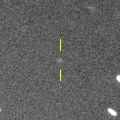
|
Now it is 16.6 mag (Oct. 26, ATLAS-HKO, Haleakala). It continues brightening even after the perihelion passage. It stays observable at 17 mag in good condition for a while.
Date(TT) R.A. (2000) Decl. Delta r Elong. m1 Best Time(A, h)
Oct. 30 5 7.31 -15 39.0 3.048 3.749 128 16.9 2:35 ( 0, 39)
Nov. 6 5 4.07 -16 4.1 3.021 3.767 132 16.9 2:04 ( 0, 39)
|
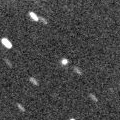
|
Now it is 16.9 mag (Oct. 22, J.-G. Bosch, F. Kugel). It is expected to brighten up to 4.5 mag in 2022 April. However, it is not observable at the high light. In the Northern Hemisphere, it stays observable until early February when it brightens up to 14 mag. Then it will appear at 6 mag in mid May, and it stays observable in good condition after that while the comet will be fading. In the Southern Hemisphere, it stays observable until December when it brightens up to 16 mag. But after that, it is not observable until 2022 August.
Date(TT) R.A. (2000) Decl. Delta r Elong. m1 Best Time(A, h)
Oct. 30 22 0.53 15 19.1 2.562 3.155 118 17.0 19:25 ( 0, 70)
Nov. 6 21 57.44 13 31.5 2.565 3.063 110 16.9 18:54 ( 0, 69)
|
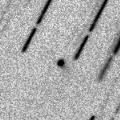
|
Michael Jager detected its cometary activity on Sept. 25. It approached to Earth down to 0.35 a.u. in early October, and it brightened up to 16.2 mag (Oct. 3, Michael Jager). Now it is fading rapidly.
Date(TT) R.A. (2000) Decl. Delta r Elong. m1 Best Time(A, h)
Oct. 30 0 49.55 -10 17.8 0.432 1.378 147 17.0 22:15 ( 0, 45)
Nov. 6 1 2.51 -12 54.9 0.475 1.396 141 17.3 22:00 ( 0, 42)
|
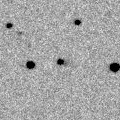
|
Now it is 15.6 mag (Oct. 13, Sandor Szabo). It is observable at 16-17 mag in good condition in autumn. It is brighter than this ephemeris recently.
Date(TT) R.A. (2000) Decl. Delta r Elong. m1 Best Time(A, h)
Oct. 30 2 16.85 15 18.3 2.805 3.798 178 17.0 23:41 ( 0, 70)
Nov. 6 2 13.46 14 39.1 2.812 3.798 172 17.0 23:10 ( 0, 70)
|

|
Now it is 17.4 mag (Oct. 11, J.-G. Bosch, F. Kugel). It stays 17-18 mag for a long time from 2021 to 2022. It is observable in excellent condition in the Northern Hemisphere, It locates somewhat low in the Southern Hemisphere.
Date(TT) R.A. (2000) Decl. Delta r Elong. m1 Best Time(A, h)
Oct. 30 4 51.24 34 28.7 4.691 5.484 139 17.1 2:20 ( 0, 90)
Nov. 6 4 40.92 34 31.5 4.608 5.473 147 17.1 1:42 ( 0, 90)
|
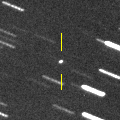
|
Now it is 16.3 mag (Oct. 24, J.-G. Bosch, F. Kugel). In the Northern Hemisphere, it stays observable in good condition after this while the comet will be fading. In the Southern Hemisphere, it stays locating extremely low for a long time.
Date(TT) R.A. (2000) Decl. Delta r Elong. m1 Best Time(A, h)
Oct. 30 5 19.77 42 16.0 2.226 2.977 131 17.1 2:48 (180, 83)
Nov. 6 5 14.18 42 40.5 2.220 3.032 138 17.1 2:15 (180, 82)
|
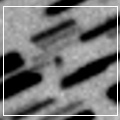
|
Now it is 17.6 mag (Oct. 17, J.-G. Bosch, F. Kugel). It is expected to brighten up to 11 mag in 2022 summer. In the Northern Hemisphere, it stays observable in good condition until 2022 June when it brightens up to 11 mag. But it is not observable after the high light. In the Souther Hemisphere, it is not observable until 2022 October.
Date(TT) R.A. (2000) Decl. Delta r Elong. m1 Best Time(A, h)
Oct. 30 23 5.89 62 5.3 3.229 3.837 121 17.4 20:29 (180, 63)
Nov. 6 22 54.73 61 11.7 3.177 3.763 119 17.3 19:51 (180, 64)
|

|
First return of a new periodic comet which brightened up to 17 mag in 2011. Now it is 16.8 mag (Oct. 10, Ken-ichi Kadota). It stays observable at 17 mag in good condition until 2022 spring.
Date(TT) R.A. (2000) Decl. Delta r Elong. m1 Best Time(A, h)
Oct. 30 10 52.32 11 4.2 1.905 1.588 56 17.4 4:53 (284, 38)
Nov. 6 11 11.91 9 12.2 1.853 1.575 58 17.3 4:59 (289, 39)
|
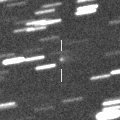
|
Now it is 16.9 mag (Oct. 7, J.-G. Bosch, F. Kugel). In the Northern Hemisphere, it stays observable at 17 mag in good condition until winter. In the Southern Hemisphere, it stays locating extremely low for a while.
Date(TT) R.A. (2000) Decl. Delta r Elong. m1 Best Time(A, h)
Oct. 30 8 57.27 27 51.3 1.921 2.126 87 17.3 4:53 (284, 69)
Nov. 6 9 4.96 26 44.2 1.869 2.155 92 17.4 4:59 (296, 74)
|

|
Now it is 18.4 mag (Oct. 10, Toshihiko Ikemura, Hirohisa Sato). It will brighten up to 16.5-17 mag in winter. In its last apparition in 2015, it brightened up to 13 mag.
Date(TT) R.A. (2000) Decl. Delta r Elong. m1 Best Time(A, h)
Oct. 30 21 50.81 -31 35.7 1.623 2.070 101 17.4 19:16 ( 0, 24)
Nov. 6 21 56.33 -30 46.2 1.661 2.030 96 17.4 18:54 ( 0, 24)
|
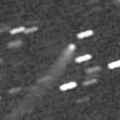
|
Now it is 16.6 mag (Oct. 17, J.-G. Bosch, F. Kugel). Fading slowly. In the Northern Hemisphere, it stays observable in good condition for a long time. It is not observable after this in the Southern Hemisphere.
Date(TT) R.A. (2000) Decl. Delta r Elong. m1 Best Time(A, h)
Oct. 30 16 22.80 47 54.5 6.276 5.971 67 17.4 18:33 (127, 37)
Nov. 6 16 25.94 47 42.6 6.314 6.006 67 17.5 18:27 (128, 34)
|

|
Now it is 18.7 mag (Oct. 14, Catalina Sky Survey). In the Northern Hemisphere, it stays observable at 17 mag in good condition from November to December. It locates low in the Southern Hemisphere.
Date(TT) R.A. (2000) Decl. Delta r Elong. m1 Best Time(A, h)
Oct. 30 4 13.13 40 19.6 1.433 2.306 143 17.7 1:42 (180, 85)
Nov. 6 3 55.93 40 3.4 1.364 2.284 151 17.5 0:57 (180, 85)
|
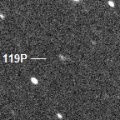
|
Now it is 17.1 mag (Oct. 2, Toshihiko Ikemura, Hirohisa Sato). It will brighten up to 15 mag in 2022 winter. In 2021, it stays observable in good condition while the comet will be brightening gradually.
Date(TT) R.A. (2000) Decl. Delta r Elong. m1 Best Time(A, h)
Oct. 30 22 22.93 -18 49.7 2.446 2.990 113 17.5 19:48 ( 0, 36)
Nov. 6 22 24.39 -18 29.2 2.513 2.965 107 17.5 19:22 ( 0, 37)
|
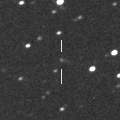
|
Now it is 17.5 mag (Oct. 26, ATLAS-MLO, Mauna Loa). It will brighten up to 14 mag in early 2023. It stays observable in good condition for a long time until spring.
Date(TT) R.A. (2000) Decl. Delta r Elong. m1 Best Time(A, h)
Oct. 30 4 51.89 2 50.4 4.558 5.358 140 17.6 2:20 ( 0, 58)
Nov. 6 4 49.76 2 39.8 4.459 5.313 146 17.5 1:50 ( 0, 58)
|

|
Now it is 21.4 mag (Aug. 19, Pan-STARRS 1, Haleakala). In the Northern Hemisphere, it stays observable at 17 mag in good condition from November to March. It locates low in the Southern Hemisphere.
Date(TT) R.A. (2000) Decl. Delta r Elong. m1 Best Time(A, h)
Oct. 30 6 6.07 20 37.2 2.012 2.707 125 17.8 3:34 ( 0, 76)
Nov. 6 6 6.85 21 11.0 1.922 2.687 131 17.7 3:07 ( 0, 76)
|
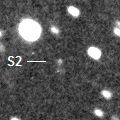
|
First return of a new periodic comet which brightened up to 17 mag in 2012. Now it is 18.4 mag (Oct. 26, Catalina Sky Survey). It is observable in excellent condition in the Southern Hemisphere. It locates low in the Northern Hemisphere.
Date(TT) R.A. (2000) Decl. Delta r Elong. m1 Best Time(A, h)
Oct. 30 21 30.69 -26 48.2 0.781 1.363 99 17.9 18:57 ( 0, 28)
Nov. 6 21 51.85 -23 41.8 0.803 1.364 98 17.9 18:50 ( 0, 32)
|
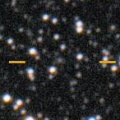
|
Now it is 17.4 mag (Oct. 2, Toshihiko Ikemura, Hirohisa Sato). It stays observable at 17-18 mag for a long time from 2021 to 2022.
Date(TT) R.A. (2000) Decl. Delta r Elong. m1 Best Time(A, h)
Oct. 30 19 29.71 -18 40.6 4.225 4.078 74 17.9 18:33 ( 27, 32)
Nov. 6 19 35.71 -18 30.9 4.320 4.075 69 17.9 18:27 ( 31, 30)
|
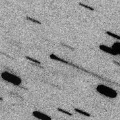
|
Now it is 18.1 mag (Oct. 3, Michael Jager). Main-belt asteroid, but it has a long tail of 10 arcmin. It stays observable in good condition until winter.
Date(TT) R.A. (2000) Decl. Delta r Elong. m1 Best Time(A, h)
Oct. 30 23 34.10 -2 49.5 1.715 2.529 136 20.0 20:59 ( 0, 52)
Nov. 6 23 34.07 -2 49.8 1.794 2.541 129 20.2 20:31 ( 0, 52)
|
|
![]()
 70P/Kojima
70P/Kojima C/2019 N1 ( ATLAS )
C/2019 N1 ( ATLAS ) 17P/Holmes
17P/Holmes C/2019 O3 ( Palomar )
C/2019 O3 ( Palomar ) 422P/2021 L1 ( Christensen )
422P/2021 L1 ( Christensen ) C/2020 F7 ( Lemmon )
C/2020 F7 ( Lemmon ) 254P/McNaught
254P/McNaught C/2021 O3 ( PanSTARRS )
C/2021 O3 ( PanSTARRS ) 2010 OE101
2010 OE101 P/2021 N2 ( Fuls )
P/2021 N2 ( Fuls ) C/2020 U4 ( PanSTARRS )
C/2020 U4 ( PanSTARRS ) 28P/Neujmin 1
28P/Neujmin 1 C/2021 P4 ( ATLAS )
C/2021 P4 ( ATLAS ) 430P/2021 Q2 ( Scotti )
430P/2021 Q2 ( Scotti ) 241P/LINEAR
241P/LINEAR 230P/LINEAR
230P/LINEAR C/2019 K7 ( Smith )
C/2019 K7 ( Smith ) (3200) Phaethon
(3200) Phaethon 119P/Parker-Hartley
119P/Parker-Hartley C/2020 S4 ( PanSTARRS )
C/2020 S4 ( PanSTARRS ) 274P/Tombaugh-Tenagra
274P/Tombaugh-Tenagra 424P/2021 L5 ( La Sagra )
424P/2021 L5 ( La Sagra ) 395P/2020 H1 ( Catalina-NEAT )
395P/2020 H1 ( Catalina-NEAT ) 433P/(248370) 2005 QN173
433P/(248370) 2005 QN173![]()



































































